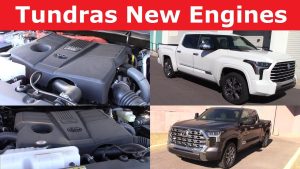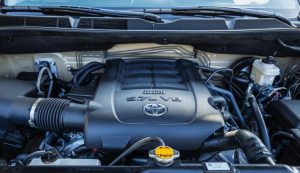There was a time when if you bought a Toyota – including a used one – you could confidently expect not to have to replace the engine.
Ever.
It would usually outlast the car.
Corollas and Camrys became two of the best-selling cars – ever – largely on account of their completely deserved reputation for reliability and durability. Neither car was especially exciting. But they (and other Toyota models such as the 4Runner and Tacoma and Tundra) were good – and that matters more in the long run than exciting. Ask any man about that.
Or woman, for that matter.
Well, that’s changed, apparently.
Toyota has announced it will replace the engines in about 100,000 Tundra pickups and 3,500 Lexus-branded SUVs that use the same 3.4 liter turbocharged V6 engine. All of them made within that past two years.
The idiot press – which isn’t so much stupid as it is ignorant (and arrogant) – “reports” that the affected engines “lose power while driving.”
Where to start?
How about the inept construction. Engines do not drive. The driver does. Engines enable the vehicle to be driven. It’s a small but not petty thing to point this out because it segues into the more serious thing, which is that the engines in these Toyota (and Lexus-badged) vehicles do not “lose power.”
They self-destruct – due to “debris” – probably metal shavings – apparently having been left inside these engines as they were assembled. This can “lead to banging or popping noises” – those being the sounds of an engine failing, familiar to anyone who has been driving an old beater that just spun a bearing or threw a rod.
They are sounds unfamiliar to the millions of people who bought Toyotas like the Camry and the Corolla – as well as the Tundra and 4runner and Tacoma – back when Toyota was making them with superbly built engines that almost never made noises like that, unless you drained the oil and ran the engine without oil. Even then, it took a while for those engines to make “banging or popping noises,” because they were just that good.
Toyota also put them together with meticulous care, which is at least as important as designing a good engine. Ask any engine builder. Leave some plastigauge on a bearing and see what happens. Forget to properly torque the head bolts and see what happens. Such things rarely, if ever, happened to Toyota engines.
So what happened?
Well, obviously, Toyota didn’t take the care it usually (historically) has taken to make sure the engines it sells are put together properly. The chief method – generally – has been to run a bunch of them down the line as pre-production engines and then run them in real-world conditions (in pre-production vehicles that are not sold to the public) long enough and hard enough to pretty much eliminate the chances of a manufacturing defect getting into production.
So why didn’t Toyota do that this time?
Probably because it didn’t have enough time to do it.
The engine at issue is the replacement for displacement – the new twin-turbo V6 that has taken the place of the anvil-reliable V8 that used to come standard in the Tundra pick-up and the SUVs “spun off” that platform, including the Lexus LX600.
Why is that V8 now longer standard?
Not because buyers of the Tundra and LX600 wanted a V6 rather than a V8. That’s just silly. Like saying people who want a two pound lobster for supper really craved a plate of that stuff that looks (and sort of tastes like) lobster – and are ok with paying lobster prices for it, too.
What’s not silly is that Toyota (and every other vehicle manufacturer) is under serious and sudden pressure to stop selling “lobster” – those anvil-reliable V8s – because as good as they were (and are) they aren’t (and cannot be made) compliant with the new regs that have been imposed over the past two years, with more (and worse) certain to come.
They used “too much” gas – to be compliant with federal regs that tell every manufacturer how many miles-per-gallon they offer for sale must deliver, irrespective of the preferences of the buyer – and never mind that it’s going to the buyer more for the vehicle to “save” on gas.
And – the bigger one – those anvil-reliable V8s “emitted” too much gas. The gas (CO2) that does not cause air pollution but which is now characterized as a “pollutant.” There is only one way to reduce the volume of this gas, which cannot be “cleaned up” because it is not “dirty.”
It is to burn less gas.
And the easiest way to do that is to reduce the size of engines – and also to keep them turned off for long as possible, as via the “mild hybrid” systems that are quickly becoming standard addendums in new vehicles (viz, the ’24 Land Cruiser, another Toyota model that used to come with a V8 but now comes with a four less than half the size – paired up with a battery and motors, to enable the four to be shut off as often as possible).
Add a turbo or two – to make up the power that’s been lost by making the engine smaller – and what you have is what’s becoming common all-of-a-sudden: An incongruity between vehicle size and engine size. Full-size trucks like the Tundra with nothing larger than a V6 the size of what you used to be able to get (as recently as last year) in a mid-sized car such as a Camry – and 5,000 lb. SUVs like the new Land Cruiser with a four cylinder engine (and mild-hybrid addendum).
Not that there’s necessarily anything wrong, per se, with these downsized/turbocharged/hybridized drivetrains.
The point is they have been rushed into service because of the pushing off the market of engines such as the V8 that used to come standard in both the Tundra and the LandCruiser – as well as similar vehicles, generally – in order for the manufacturers of those vehicles to be able to continue selling the vehicles that those engines used to power.
And when anything is rushed, the chances of something going wrong increase.
This compounds when what is rushed is also more complex, as is true of an engine with more parts that must be manufactured and assembled with exactitude – and new machinery and processes that maybe haven’t yet been entirely sorted out.
This may account for the need to replace 100,000 essentially brand-new engines that may “lose power while driving,” or that make “banging or popping noises.”
Other noises may follow.
Such as the howls of anger emanating from the 100,000 buyers of Toyota/Lexus vehicles that now own vehicles with replacement engines that may not “lose power while driving” or make “banging or popping noises.” But maybe they will. And who knows?
Only time will tell.
What is known is these buyers confidence in Toyota as the anvil-reliable brand has surely been shaken. Because Toyota has been effectively forced to take the anvils out of production. it’s not just Toyota, either. Honda’s superb V6 is almost a goner – and soon will be – in favor of turbo/hybrid fours across the line. The same has happened to what used to be Mazda’s equally excellent V6 and Subaru’s flat six.
You can no longer get a V8 in a Ram pickup. Not even optionally. Ford and GM are likely to follow, soon. Because they will be forced to. It is the only way to comply.
Assuming you haven’t got the guts to resist.
. . .
If you like what you’ve found here please consider supporting EPautos.
We depend on you to keep the wheels turning!
Our donate button is here.
If you prefer not to use PayPal, our mailing address is:
EPautos
721 Hummingbird Lane SE
Copper Hill, VA 24079
PS: Get an EPautos magnet or sticker or coaster in return for a $20 or more one-time donation or a $10 or more monthly recurring donation. (Please be sure to tell us you want a magnet or sticker or coaster – and also, provide an address, so we know where to mail the thing!)
If you like items like the Baaaaaa! baseball cap pictured below, you can find that and more at the EPautos store!













If someone gave me a brand new truck (any brand), I would immediately sell it and buy a mid 60’s to late 70’s square body, maybe 3 or 4 of them at current prices.
“always reliable…” HAH!
Remember the nickname of the camry originally – 40,000 mile camera”?
Here’s a little project for ya; go and look at how many ‘single marque’ independent repair facilities there are in your area. Now see how many are specific to tojo and h**da. They gotta stay in business…
Then stop believing the hype you read.
On the bright side, we got this: https://s3mag.com/toyota-is-resurrecting-mr2-celica/
1987 Toyota pickup. Not a Taco or a Tundra, just a pickup. Power from the Toyota 22R four. Over 300K miles, my son and I replaced the head gasket about 150K miles. Runs like a sewing machine, paid $700 for it in 1997; and we will never sell it – because of the 22R. We also have a 1978 Chevrolet Caprice station wagon, with the amazing carbureted small block Chevy. I remember years ago – early 70s – that GM had at that point had made over 38 million Chevy small blocks; parts will not be a problem, ever. I’d also read “keep clean oil in them and they will last forever”. Ours is over 300K miles at this time as well, with clean oil…
Our “new” vehicle is an 04 Excursion diesel. Anyone who buys one of these “new and improved” vehicles/engines doesn’t know shit about anything automotive.
Preach it, Grandpa!
I’m not getting rid of any of my old stuff, either. Viva Cuba!
I had a celica with the 20R and 5 speed. 280K when the body rotted out.
Similar happenings over on the Honda side with the V6. The port injection Honda V6 was damn near bulletproof. Ever since direct injection came into play, problems. We’re in the middle of a massive recall to replace the rod bearings with a ‘heavy duty’ version on many of them. Some of them get new crankshafts and main bearings too. Why? They chew up the rod bearings, which eventually leads to a spun bearing. This was explained as a problem with improperly ground crankshafts, yet the recall spans five model years. What happened to QC? Why did it take almost a decade after the problem started to provide a fix?
Obliterated Honda Accord J35Z2 V6 Teardown…..a look inside…
VCM problems…. Variable cylinder management….
The more high tech they make these engines, the more unreliable they get…
https://www.youtube.com/watch?v=jKmNNBLfFlY
J35Z2 has multi port fuel injection
It has VCM problems…. Variable cylinder management….
J35Y4 – VCM
2014-2020 Acura RLX/Honda Legend
has Direct Injection….then it got worse….
“Guts to resist” gets you kidnapped at gunpoint and buried alive in a locked cage.
Depends how you resist. My imagination had me screaming at Congress that they have “made war on the States” by what they have done to cars and should be put to DEATH for it. That fantasy would indeed get one locked in a cage. One can think of many similar actions.
A better one is to buy only used cars that ARE cars, preferably 20th century. Something like that is heading off electric cars. People might be USED to buying new cars but we need to wake up and see where mindless compliance is getting us.
Use cash instead of credit cards or checks.
Go to Freedom Law School and find out how to legally avoid paying income tax, which supports all the BigGov demons. (Do it right or not at all–they cheat to jail those who make mistakes)
Improve Freedom in general by visiting and joining CSPOA–Constitutional Sheriffs and Peace Officers Association.
Throw away your TV set.
Continue to search for alternative news that actually tells you the truth.
Hi LadyLife,
I like (and amen) all you’ve written. Opting out – going gray – is one of the most effective weapons we have, if only enough of of us would used it. Here’s hoping more will!
A deep dive into the Toyota V6 Turbo engine failure issue….
Debris causing it…or a different issue?…number one and four crankshaft bearings are failing….the part number for these are changing…new replacements are coming ….
https://www.youtube.com/watch?v=EyI4ujjxxuk
I work in engineering for the “lower case car company” and I can tell you this…..the higher ups here have been convinced that all physical development testing can be replaced with math based virtual testing. Convinced mainly by the army of math folks in the company who swoop in at future product development plannings and undercut the testing folk with super low-cost Nintendo style testing. You can see how well that will end. I got to believe this mania has spread to all the OEM’s.
Makes you wonder if a similar mania hasn’t also overtaken Boeing, et. al. which is why planes are becoming a far less safe affair then they’ve been for the last several decades.
Yup!! I’ve lived this same scenario at two other OEMs besides yours.
Though I sometimes feel a yearning for having left the industry, I have to remind myself that it no longer is what it once was.
Now run by finance types. Senior management is fully bought into the Davos / Climate change BS. They have less than zero regard for what the customer wants, needs, or can afford. What government wants they get whether mandated by regulations or not.
I won’t shed a tear when the house of cards finally falls.
But the math folks (and finance folks) just stepped on their dicks, didn’t they? It is obvious that boring old real world QA would have identified the issue. It sure as hell can’t be more expensive than replacing more than 100K engines.
ROFL LMAO. You men-creatures are so FUNNY! And you are NOT replaceable by women.
For all his faults, at least at SpaceX, Elon Musk buys into test-fix-test methodology.
“How it should work” and “how it actually works” are not always the same thing.
Case in point: Warp Speed.
This is the “tech” sector’s Achilles heel.
98% of “good” ideas fail to survive contact with reality. Anyone who doesn’t have the luxury of “working from home” all the time knows that all too well.
Management is about to learn a lot of very expensive lessons (we can all hope) (the alternative is that the whole ship sinks).
Besides putting us into the position of having $60K-$70K trucks and SUVs that don’t work, the “fix” will be higher prices going forward. Management will not suffer. Management will continue to go along with Big Guv, and we will continue to fund Toyota’s profits. When NYC goes broke with Marxist governance, NYC turns to the U.S. taxpayer to pay. Same here. Lose money on recalls? Make up the profit on next year’s sales.
Indeed, Richard –
This is axiomatic – because the complexity (and cost) of new vehicles will necessarily wax as the difficulty of “achieving compliance” increases. Hold on to your older vehicle, if you have one. And if you don’t, get one. Before you can’t.
Toyota has a problem, can’t deny it. However, their hands are tied, dotgov says so.
If you assign blame, who is at fault, dotgov will never admit the error, no guilt, only denial. It’ll be your fault, as always.
If you keep your nose to the grindstone, you’ll keep it out of other peoples’ business.
The solution is to buy used and to know what you are buying. Was looking at a used Tacoma a while back, 1994 or 1996, can’t remember, then it was gone at the dealership site. You snooze you lose. The price was right.
My uncle bought a brand new John Deere combine ca. 1980.
He ran it for about 10 hours, then changed all of the engine oil to remove any grindings from the manufactured engine.
What the book said to do. Break-in oil.
“When it came from God…”, a John Deere salesman’s words, words do a lot of selling.
I would love to see one of the automakers with their high powered lawyers sue the EPA in court to actually PROVE that CO2 is a “greenhouse gas”, not merely assert it. With the Supremes recently “Chevron deference” ruling now is the time to take on these agencies; the EPA ruling on CO2 “because we say so” wouldn’t fly. How about some actual evidence/proof?
Having been an automotive industry engineer since the mid 90s, Toyota’s problem isn’t surprising.
There has been a continual, decades long push to reduce development time, while simultaneously decreasing pre-production prototypes. Drastically.
Toyota led this charge and the other OEMs have rushed to follow.
When I first started in the industry, it wasn’t uncommon to build several hundred prototypes. When I left in 2022, we were typically building 50-70 prototypes. Usually less than 100. Having enough vehicles to do testing with became a huge problem.
Often there were only one or two vehicles with a needed engine, transmission, feature set. Engineers are pushed to do testing that would take a week in a matter of days due to limited vehicle availability.
Toyota is just beginning to reap what it has sown. There will be similar failures throughout the industry.
“Toyota is just beginning to reap what it has sown.” What Toyota has sown is craven “compliance.”
With few exceptions, Toyota has never been cutting edge or flashy. It’s entire stock in trade has been rock-solid reliability at the cost of being conservative and stodgy. You’d think after the rotting frame debacle they would have been more careful.
Hi Bid,
Could this recall also just be a blip on the radar of what our supply chain looked like in 2021-2023? I believe we all realized that car manufacturers were just throwing vehicles together to get them out the door…and onto the lots. Remember 2022? There were no new cars anywhere to be found. It is what caused the price surge in the used auto market.
I don’t expect this to be the end of recalls especially on any vehicle made over the last three years, but I don’t believe this will continue and Toyota/Lexus will right the ship. Now if they would just get rid of those horrible IPad looking screens….
Yeah for sure the supply chain and lack of quality could be related to the CovidCon.
However, the real supply chain constraints were microchips not things like castings and machined engine parts.
Could have been different issues for different OEMs.
This is happening in all industries, and has taken place since the successful US takedown of the twin towers and the Pentagon based on 19 camel riders from the Sahara desert. Clearly a lie, this was swallowed by a majority of the public, and since then lying by all companies is now the norm. No information coming from a corporation or government can be trusted. If you now take every thing those groups of creatures say, all the events happening now, big and small, all make sense.
That is my theory and I can back it up with all the world events that have taken place in the last 23 years.
The 6.4 Hemi is still available in the Ram 3500, but only in the work truck trim levels. If you want a nice interior, diesel is the only option. Looks like I’ll be keeping my ’19 Laramie 3500 for the long haul.
Bought a CX-50 earlier this year. Nice car, but would be much better with that Mazda V6 we can’t get anymore. I’ve been following the CX-50 subreddit, and at least in that group there are far more ‘when is the hybrid coming?’ comments than ‘where’s the V6?’. But everyone hates the compliance seat belt chime.
“Boeing management’s thinking at the time was they should capitalize on the skills they had in their workforce and profit from it. Management considered it their job to find or create projects that would do just that and keep the factory running.”
https://youtu.be/T7GUf9wDs9U?si=RDMnUOLBrEHAee4K
Toyota’s reputation came from the factory floor, not the marketing department. The men on the line wanted perfection every bit as much as the customer and attempted to deliver it. And because Toyota had a certain amount of prestige associated with working there, they could draw from a better workforce. Maybe the depression and war had something to do with it, IDK. People were happy to have a job, managers were happy to have a set of skilled workers who weren’t calling for communism.
At one time the Toyota model was how every successful factory was run, more or less. But then the accountants took over the C-suite, and going down to the floor was considered unseemly. Production was just a line item on the budget next to SG&A and taxes. “Human resources” were no more important than steel or microchips. Didn’t help that the next generation of factory workers felt entitled instead of grateful. Quality suffered. HR worried about lawsuits. The highly skilled workforce became semi-skilled, then unskilled. Then came the robots, and the design requirements changed to suit the robots. And the outsourcing, under the guise of cost savings -really just about creating the illusion of high paying factory jobs while the factory is sourcing cheap low cost labor by proxy. Shipping became more important to the production line than labor showing up sober.
I don’t have a solution, just that history doesn’t look good for manufacturing in the 1st world. Maybe big companies need to die so that new firms can pull the wheat from the chaff of the labor pool. But then what to do with the chaff? Chaff sitting around with nothing to do tends to believe any political charlatan that comes down the pike. Not good for business.
Such is what happens when accountants take over management. Instead of simply advising management.
Generally speaking it tends to work better if management comes from the banks of engineering or R&D. Sales, even—because they recognize the marketplace value of a high quality product.
In general accountant CEOs tend to result in a race to the bottom for employees , prices, and the product itself. I know a few exceptions but that seems to be the trend. Most MBAs are just idiot lemmings who don’t actually know how to do anything so they jump on the next management fad. Lawyers can be pretty sharp, but usually have to muddle through some things because they have no idea how anything actually works in practice. I’ve never had a CEO with a HR background but looking at GM I’m not impressed. The key to the top tier appears to be having the right drinking buddies and/or family connections.
It’s the Jews…ALWAYS the JOOs…
“Never underestimate the State’s ability to fuck things up.”
It has never done anything good. They are like flies. All they do is eat shit and bother people.
Personally Eric,,, I’m not sure too many really care. American bobble heads buy whatever is available regardless of any problems. They complain later! They could sell these morons Flintstone vehicles powered with pedals and chains. Costs don’t matter,,, they’ll find workarounds like they do these days. Lease,,, 20year financing. Trade for their homes.
Insanity has proven to be infectious and communicable in the last thirty years. The bottom IQ 10 percent and the sexual deviants taking control of genders and pronouns,,, a la Olympics last supper and other crazy shyt most Christians ignore to prevent any possibility of holding the vile vermin responsible.
Jesus said ‘Turn the Cheek’. They purged the previous line that went beat the crap out of them!
With wheels and parts falling off new aircraft in flight it would seem new automotive self demolishing engines no big surprise. The answer? Buy electric next time dufas.
Years ago, there was a Louisiana oil industry bubba who would drive his Tundra to/from the oil fields in the Dakotas. He did this over the years & eventually put a million miles on his truck. Toyota got wind of it, bought the truck and gave him a new Tundra in order to examine how their engine got a million miles.
That’s what we should strive for, not, chasing unicorns of “net zero” dreamed up by soyboys in the Bill Clinton building on 12th Street.
An additional curiosity:
‘The [recalled] V35A 3.4-liter V-6 engine is supplied from the Tahara plant in Japan for Toyota Auto Body and from Toyota Motor Manufacturing, Alabama for the automaker’s assembly plant in San Antonio.’
https://archive.ph/YgcXl#selection-7691.0-7691.189
Recalled engines from two different plants — one in Japan and one in the US — complicates the picture. It tends to suggest a basic manufacturing process error common to both plants.
The NHTSA got involved because ‘a loss of drive power increases the risk of a crash.’ It does, but that remote risk is completely peripheral to a quality defect that bricks an engine.
As George W Bush used to ask, ‘Is our kids learning at stenography skool?’ Is this pencil edible? Will it work as an ear plug? Me learn good!
probably chinese steel that is garbage or chinese parts stamped for toyota. the high end luxury cars also have parts made in china for the german factories. a cheat and a con. almost all auto manufacturers do the same thing. the part will have a made in china stamp on it or a number that designates what ‘factory’ made it. nice huh. they don’t tell you about that stuff.
things made in china are replicas. fakes that look real and are not meant to be used…just looked at like garden tools that have ceramic cores and steel looking metal on the outside and it breaks or bends in half on the first use!
they make engines the same way…they make military hardware and airplane parts! same techniques of garbage passed off as a useable part.
so their engines are coming apart at toyota and i would bet the main cause will be a part made in china and assemblied in japan usa….
We will certainly be living in interesting times once Boeing goes bust and Chinese airplane manufacturers take over their market share…
80% of the important parts for EV’s and their batteries come from China….
EV’s are the most unreliable and problem filled vehicles ever made….maybe there is a connection…
The next problem is there is almost zero techs around that know how to diagnose and fix these EV’s….so there are brand new EV’s being scrapped…can’t be fixed….
They are bit like a McLaren…if a McLaren is in and accident, it has to be shipped back to the factory…nobody is qualified to repair it….it is very high tech….
‘debris from the manufacturing process may have been left inside the engine where it can lead to banging or popping noises’ — CNN
Yeah, right — like the ‘banging and popping noises’ reported by presstitutes at a political rally in Butler, Pennsylvania, when Trump suddenly, inexplicably ‘fell’ to the ground.
Causation, of necessity, must take a back seat when regime scribblers are directed to report in the passive voice based on impressions, while factual investigation is rigorously excluded or left to the province of omniscient, objective Big Gov. /sarc
Death to the Lügenpresse.
‘As the campaign enters the final stretch, the behavior of Big Tech search engines, social media and establishment news organizations [is changing]. Search terms for Donald Trump have been suspiciously absent on Google. Trump’s speeches are being consistently edited out of context. And, media platforms are blatantly parroting the same scripted talking points in a way that would make Joseph Goebbels blush.
‘As Goebbels once stated: “Think of the press as a great keyboard on which the government can play.”
‘This mantra has never been more obvious than it is today. The new narrative that every progressive shill is reciting on nearly every major news platform? Donald Trump and JD Vance are ‘just plain weird,’ and conservatives are all weird by extension …’
https://www.zerohedge.com/political/media-shills-have-received-their-new-script-conservatives-are-weird
‘Biden’s’ remarks to the press pool in Austin yesterday:
Q: Speaker Johnson said it’s “dead on arrival.”
BIDEN: I think that’s what he is.
Q: That he is?
BIDEN: That he is — dead on arrival. *sound of banging and popping noises*
And the video of him reading from a teleprompter saying he removed his hand, it was covered with blood. The video shows otherwise.
And the latest video of him with Satanyahoo shows a complete ear,,, not even a scab. I guess with his new god appointment he just repaired the ear with a wave of his hand.
The bullet didn’t hit his ear, the concussion from the velocity made is eardrum bleed. A shockwave can do that. Very good possibility, in the realm of a fact.
Shot at and missed, an old story there.